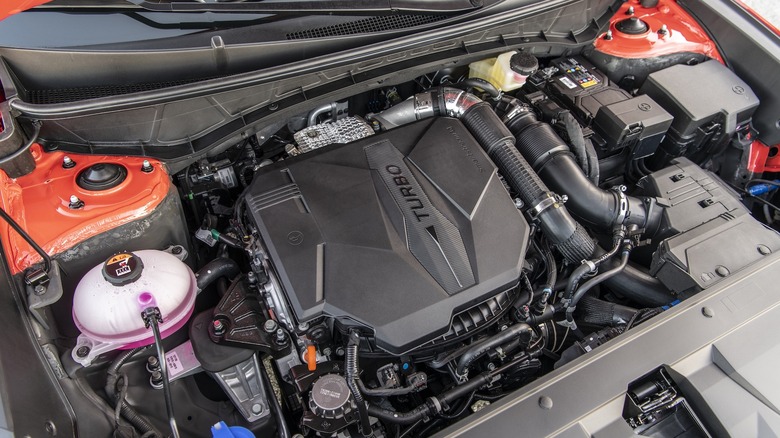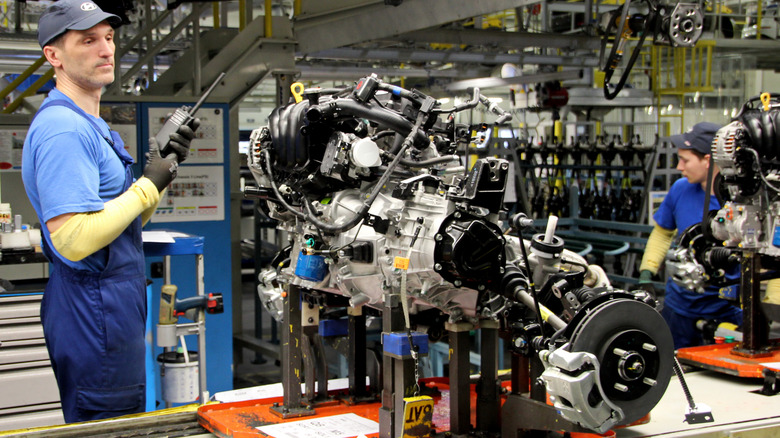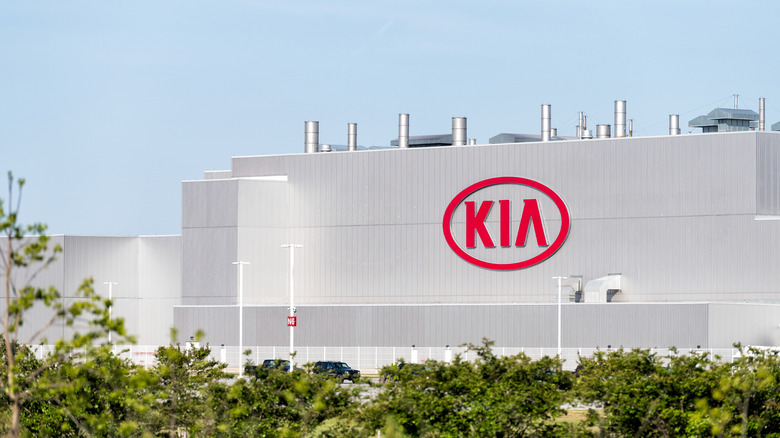Who Makes Kia Engines And Are They The Same As Hyundai's?
Since entering the U.S. market in 1986 and 1994, respectively, Hyundai and Kia have steadily worked their way up the automotive value chain. From suppliers of cheap, cheerful, but somewhat nondescript vehicles, the Korean cousins now produce innovative, stylish designs that can go head-to-head with respected Japanese brands like Toyota, Mazda, and Honda. While Kia has its own unique history as a car manufacturer, it has been under the umbrella of parent company Hyundai Motor Group since a bailout in the midst of the Asian Economic Crisis in 1998.
Being part of the same company means these South Korean marques can — and frequently do — share infrastructure and parts, including engines. You will find the same 1.4-liter Hyundai Gamma inline-four in Kia's Rio and Ceed models as in the Hyundai Accent, i20, and i30. Likewise, Hyundai's 3.8-liter V6 Lambda lurks under the hoods of both the Hyundai Palisade and the Kia Telluride, with both models set to switch to the more efficient 3.5-liter powerplant for their 2026 model year.
There are plenty more examples where Kia and Hyundai models share the same powertrain, which is not to say Kia doesn't build its own engines — it does. But complex global supply chains mean it often makes good financial sense for carmakers to share infrastructure and intellectual property across brands and borders. In August 2025, for example, U.S. carmaker General Motors agreed to develop vehicles with Hyundai, while Kia is high on the list of the most American-built vehicles in the U.S. today.
Same destination, different road
While Kia and its parent company share knowledge and resources, building similar vehicles in similar ways in factories right across the globe, each travels its own road. The two brands house their factories separately — even within their home country. In Korea, Kia builds vehicles in Hwasung, Gwangju, Sohari, and Seosan, while Hyundais are made in Ulsan, Asan, and Jeonju. In Europe, both brands build engines to meet the E.U.'s stringent emissions regulations – but Kia operates out of Slovakia, while Hyundai works from the Czech Republic.
In the U.S., Hyundai builds vehicles in Montgomery, Alabama, while Kia's plant is located in West Point, Georgia. Every Kia model made in the U.S. — including the Kia Telluride, Sportage, Sorento, K5, and the EV9 SUV – is built at the Kia Motors Manufacturing Georgia (KMMG) plant. However, many of the engines in these Kias come from three engine shops at the Hyundai Motor Manufacturing Alabama (HMMA) in Alabama, which means some of the most reliable Kia engines ever made were actually built by Hyundai.
American workers at HMMA make the new Smartstream G2.5 GDI, G1.6 T-GDI, G2.0 Atkinson, G2.5 GDI, and G2.5 T-GDI engines, used both in Hyundais built at the plant and Kias assembled in Georgia. Both automakers share knowledge from a Hyundai/Kia research center in Irvine, California, and an engineering facility in Detroit, Michigan, with the separate Hyundai Motor Group Metaplant America (HMGMA) in Georgia dedicated to building EVs.
Shared resources, shared problems
Both Kia and Hyundai made a name for themselves with American consumers by offering an unprecedented 10-year, 100,000-mile warranty on their powertrains. Unfortunately, this magnanimous gesture didn't translate to their engines being more reliable than their competitors'. Built at the Hyundai plant in Alabama from 2009, the notorious Theta II engine was used in the Kia Forte, Forte Koup, Optima, Sorento, and Sportage models throughout the following decade. The engine had a woeful reputation, with a number of common problems that could cause it to seize.
NHTSA (link will download a PDF to your device) documents show the manufacturing process left behind metallic debris that could obstruct oil galleries and restrict the flow of lubricant at the crankshaft. Nearly half a million 2011 and 2012 Hyundai models were recalled in 2015, with Kia following suit two years later after the problem was found to be present in a wider range of models.
Originally, Hyundai Motor claimed the flaws were only present in U.S.-built engines, but in 2016, there were reports of Korean-built cars with Theta II engines coming suddenly to a stop while driving due to crankshaft problems. After the Korea Transportation Safety Authority confirmed (via the Korea Herald) three reports of malfunctioning engines, including a K5 2.0 T-GDI that caught fire, Hyundai and Kia were forced to recall more than 170,000 Korean-built vehicles across five different models with Theta 2 engines made before August 2013. Nearly a decade on, these teething problems have mostly been sorted, and Hyundai is teaming up with GM to compete with the flood of cheap EVs from China.


